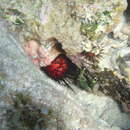en
names in breadcrumbs


The crab Mithraculus sculptus, commonly known as the Green Clinging Crab or the Green Emerald Crab, is a small crustacean found in shallow areas of the tropical Western Atlantic (Rhyne et al. 2006). It has been found in areas from Miami to northern Brazil, and is common in the intermediate islands of the Bahamas and Caribbean (Williams 1984). Previously known as Mithrax sculptus, the species was name was changed to Mithraculus scultpus after a motion by White in 1847 to split Mithrax into two subgenera, Mithrax and Mithraculus due to physiological differences (White 1847). Recent studies on the molecular phylogeny of M. sculptus suggest that this distinction may not be an accurate reflection of the genetic phylogeny (Baeza et al. 2010). Studies into the larval development of the Mithrax-Mithraculus complex also detract from the validity of splitting Mithrax into subgenera, but the current designation has not yet changed (Rhyne et al. 2006).
Mithraculus sculptus is a small crab with an attractive green coloration that is well equipped to dine on a variety of foods, most commonly filamentous or fleshy algae and other vegetation (Penha-Lopes et al. 2006). These two characteristics, the decorative appearance and algae targeted herbivory, make M. sculptus extremely popular in tropical aquacultures (Figueiredo 2008). Though it is not well researched, some researchers believe M. sculptus to be one of the most heavily traded crustaceans for aquarium use (Rhyne et al. 2006).
Mithraculus sculptus, the green clinging crab[3] or emerald crab, is a species of crab in the family Majidae. It is a dark green colour and is found in tropical waters in the Caribbean Sea. It is sometimes kept in reef aquaria.
Mithraculus sculptus is a small crab with a carapace longer than it is wide and large chelae (claws). The carapace is flat, shiny and green, finely sculpted, with whitish material adhering to the projections. The chelae are also green and are spoon-shaped and tipped with white. The walking legs are rather paler in colour and are hairy and often covered with encrustations. This crab grows to a length of about 4 cm (1.6 in).[4]
Mithraculus sculptus is native to the Caribbean Sea and Gulf of Mexico. Its range extends from the Bahamas and southern Florida to the northern part of Brazil at depths down to about 54 metres (177 ft). It is found in a number of varied habitats but may be most abundant in back reef environments.[4]
Mithraculus sculptus is largely nocturnal, hiding in caves, crevices and under rocks during the day. It is principally a scavenger but it also feeds on algae.[5] It is tolerant of both high and low temperatures and is capable of withstanding strong currents as it can use its legs to cling on to the substrate.[6] It is often to be seen among the branches of corals such as the Porites furcata. It also feeds on organisms encrusting the leaf blades of turtle grass (Thalassia testudinum). When threatened it often hides beneath the extended tentacles of the sun anemone (Stichodactyla helianthus).[4]
Mithraculus sculptus is sometimes kept in reef aquaria where it is said to be compatible with other reef species. It will feed on algae including bubble algae (Valonia ventricosa) and eat any left-over meaty foods but, if it is underfed, may consume coral polyps or small fish.[5] Research has shown that it can be used to control excessive growth of bubble algae in aquaria, but best results are found when its diet is supplemented with mysids but not with pelleted food.[7]
Mithraculus sculptus, the green clinging crab or emerald crab, is a species of crab in the family Majidae. It is a dark green colour and is found in tropical waters in the Caribbean Sea. It is sometimes kept in reef aquaria.